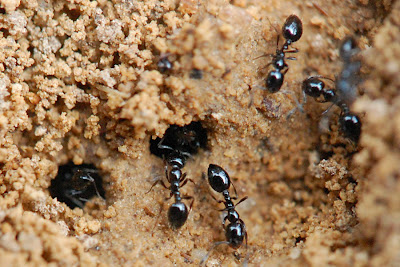Interactions
When in an environment shared by many different species there
will be constant interaction. Monomorium minimum competes,
predates, and invades copious amounts of organisms and their
environments. The ant M. minimum has various features that allow
it to have influence over other species.
 M. minimum
are sometimes harmful to many forms of life such as plants and
animals. They like to eat pollen from
various flowering plants such as honeydew (Smith 1965,
School of Ants 2011). With too many ants constantly overwhelming
one plant, they may eventually kill it. These organisms can be
detrimental to various species of animals. For instance, M. minimum have
harmed freshly hatched bluebirds resulting in the death of these
baby birds (Smith 1965). They also eat other insects which makes them predators and
carnivores (Smith 1965, Texas A&M AgriLife Research
Extension 2010).
M. minimum
are sometimes harmful to many forms of life such as plants and
animals. They like to eat pollen from
various flowering plants such as honeydew (Smith 1965,
School of Ants 2011). With too many ants constantly overwhelming
one plant, they may eventually kill it. These organisms can be
detrimental to various species of animals. For instance, M. minimum have
harmed freshly hatched bluebirds resulting in the death of these
baby birds (Smith 1965). They also eat other insects which makes them predators and
carnivores (Smith 1965, Texas A&M AgriLife Research
Extension 2010).
M. minimum
can also affect humans and their habitats. As mentioned on
the Habitat page, they can make
their way into human households and abide within the wood
molding (Smith 1965). The ants are seen as unwanted pests (Smith
1965, School of Ants 2011). They are attracted to different food items within
people’s houses such as fruits and meats (Smith 1965). This can
be an annoyance to humans because they do not want these insects
getting into their food or living within their homes.
M. minimum
use their sting in order to keep their competitors from taking
their food (Adams and Traniello 1981, School of Ants 2011). They release a toxin
which keeps the competition from approaching the food source for
a period of time giving the M. minimum more time in order to
break the food particle up and gather it (Adams and Traniello
1981). The use of their sting allows them to have an
advantage over other species when in a competitive situation.
One specific species that the M. minimum comes in contact with
is Lasius neoniger. Some of the M.
minimum run when in the presence of L. neoniger, while other M.
minimum continue to remain by the food because they want the
resource (Adams and Traniello 1981). When these two species
fight for a piece of food, the organism L. neoniger tries to
defend and scare away the M. minimum from the desired source.
Unfortunately for the L. neoniger, the M. minimum fights back (Adams and
Traniello 1981, School of Ants 2011). The M. minimum
leads its defensive attack by using their
specialized stinger. This feature harms the L. neoniger and causes
an almost
immediate bad reaction to the Lasius neoniger (Adams and
Traniello 1981).
M. minimum
also interacts with the species Solenopsis invicta. If these two
species are closer together, M. minimum is more likely to take
over the S. invicta colonies. If these territories
are farther apart, this invasion will be less likely to happen
(Rao and Vinson 2007). M. minimum is also more likely to
attack S. invicta territories if they are hungry or in need of a
food resource (Rao and Vinson 2007, School of Ants 2011). In order for M.
minimum to take over a population of S. invicta, they
just need 30 members (Rao and Vinson 2007). The species M.
minimum have dominance over the species S. invicta.
Additionally, M.
minimum interacts with Monomorium pharanis. Both M. minimum and
M. pharanis leave pheromone paths in order for other ants in
their species to find the food they have found (Mashaly
2010). M. minimum will not just follow its own paths but the
paths of M. pharanis as well (Mashaly 2010). This could
be beneficial to the M. minimum because they could get led to
different food sources without a lot of effort on their species'
part.
M. minimum have diverse relationships with different organisms. They can gain many benefits from these organisms, however they can also be harmful by these other organisms causing their demises.
Click here for some interesting Facts about M. minimum.
Click here to return to the Home page.
.jpg)